2021 FORD F-150 traction control
[x] Cancel search: traction controlPage 14 of 796
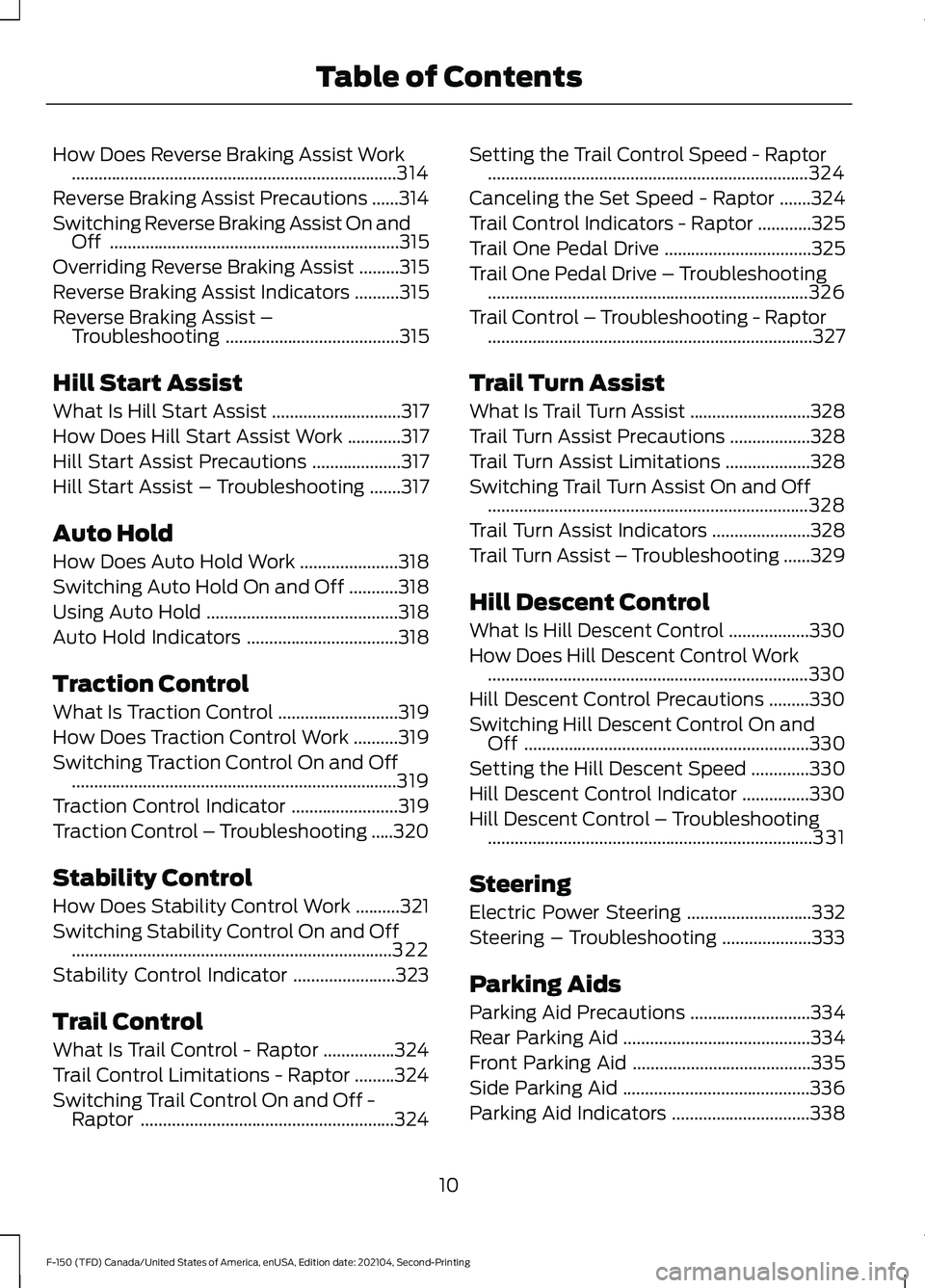
How Does Reverse Braking Assist Work
........................................................................\
.314
Reverse Braking Assist Precautions ......
314
Switching Reverse Braking Assist On and Off .................................................................
315
Overriding Reverse Braking Assist .........
315
Reverse Braking Assist Indicators ..........
315
Reverse Braking Assist – Troubleshooting .......................................
315
Hill Start Assist
What Is Hill Start Assist .............................
317
How Does Hill Start Assist Work ............
317
Hill Start Assist Precautions ....................
317
Hill Start Assist – Troubleshooting .......
317
Auto Hold
How Does Auto Hold Work ......................
318
Switching Auto Hold On and Off ...........
318
Using Auto Hold ...........................................
318
Auto Hold Indicators ..................................
318
Traction Control
What Is Traction Control ...........................
319
How Does Traction Control Work ..........
319
Switching Traction Control On and Off ........................................................................\
.
319
Traction Control Indicator ........................
319
Traction Control – Troubleshooting .....
320
Stability Control
How Does Stability Control Work ..........
321
Switching Stability Control On and Off ........................................................................\
322
Stability Control Indicator .......................
323
Trail Control
What Is Trail Control - Raptor ................
324
Trail Control Limitations - Raptor .........
324
Switching Trail Control On and Off - Raptor .........................................................
324 Setting the Trail Control Speed - Raptor
........................................................................\
324
Canceling the Set Speed - Raptor .......
324
Trail Control Indicators - Raptor ............
325
Trail One Pedal Drive .................................
325
Trail One Pedal Drive – Troubleshooting ........................................................................\
326
Trail Control – Troubleshooting - Raptor ........................................................................\
.
327
Trail Turn Assist
What Is Trail Turn Assist ...........................
328
Trail Turn Assist Precautions ..................
328
Trail Turn Assist Limitations ...................
328
Switching Trail Turn Assist On and Off ........................................................................\
328
Trail Turn Assist Indicators ......................
328
Trail Turn Assist – Troubleshooting ......
329
Hill Descent Control
What Is Hill Descent Control ..................
330
How Does Hill Descent Control Work ........................................................................\
330
Hill Descent Control Precautions .........
330
Switching Hill Descent Control On and Off ................................................................
330
Setting the Hill Descent Speed .............
330
Hill Descent Control Indicator ...............
330
Hill Descent Control – Troubleshooting ........................................................................\
.
331
Steering
Electric Power Steering ............................
332
Steering – Troubleshooting ....................
333
Parking Aids
Parking Aid Precautions ...........................
334
Rear Parking Aid ..........................................
334
Front Parking Aid ........................................
335
Side Parking Aid ..........................................
336
Parking Aid Indicators ...............................
338
10
F-150 (TFD) Canada/United States of America, enUSA, Edition date: 202104, Second-Printing Table of Contents
Page 41 of 796
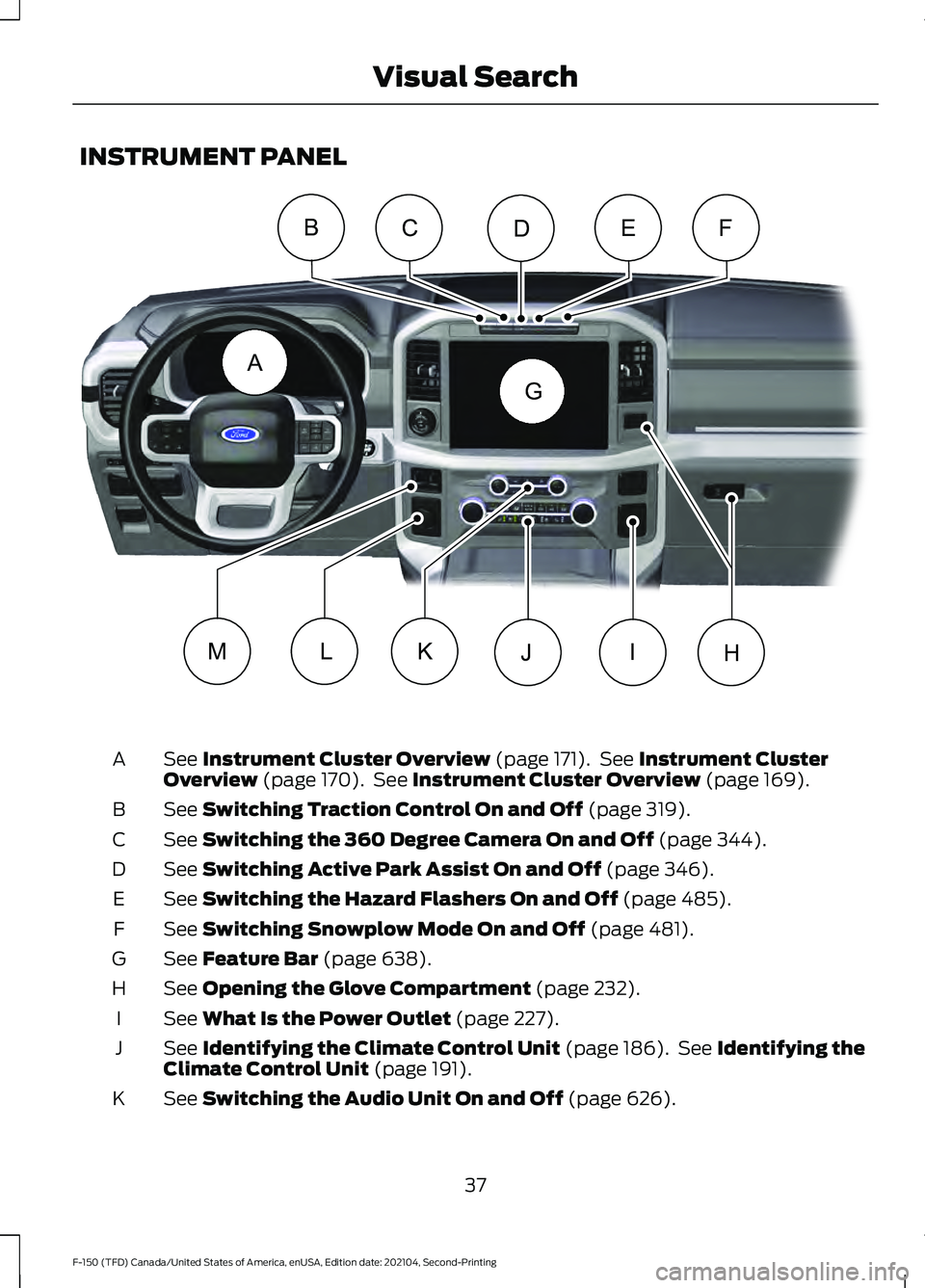
INSTRUMENT PANEL
See Instrument Cluster Overview (page 171). See Instrument Cluster
Overview (page 170). See Instrument Cluster Overview (page 169).
A
See
Switching Traction Control On and Off (page 319).
B
See
Switching the 360 Degree Camera On and Off (page 344).
C
See
Switching Active Park Assist On and Off (page 346).
D
See
Switching the Hazard Flashers On and Off (page 485).
E
See
Switching Snowplow Mode On and Off (page 481).
F
See
Feature Bar (page 638).
G
See
Opening the Glove Compartment (page 232).
H
See
What Is the Power Outlet (page 227).
I
See
Identifying the Climate Control Unit (page 186). See Identifying the
Climate Control Unit (page 191).
J
See
Switching the Audio Unit On and Off (page 626).
K
37
F-150 (TFD) Canada/United States of America, enUSA, Edition date: 202104, Second-Printing Visual SearchA
BCEFD
G
IJKLMHE328453
Page 43 of 796
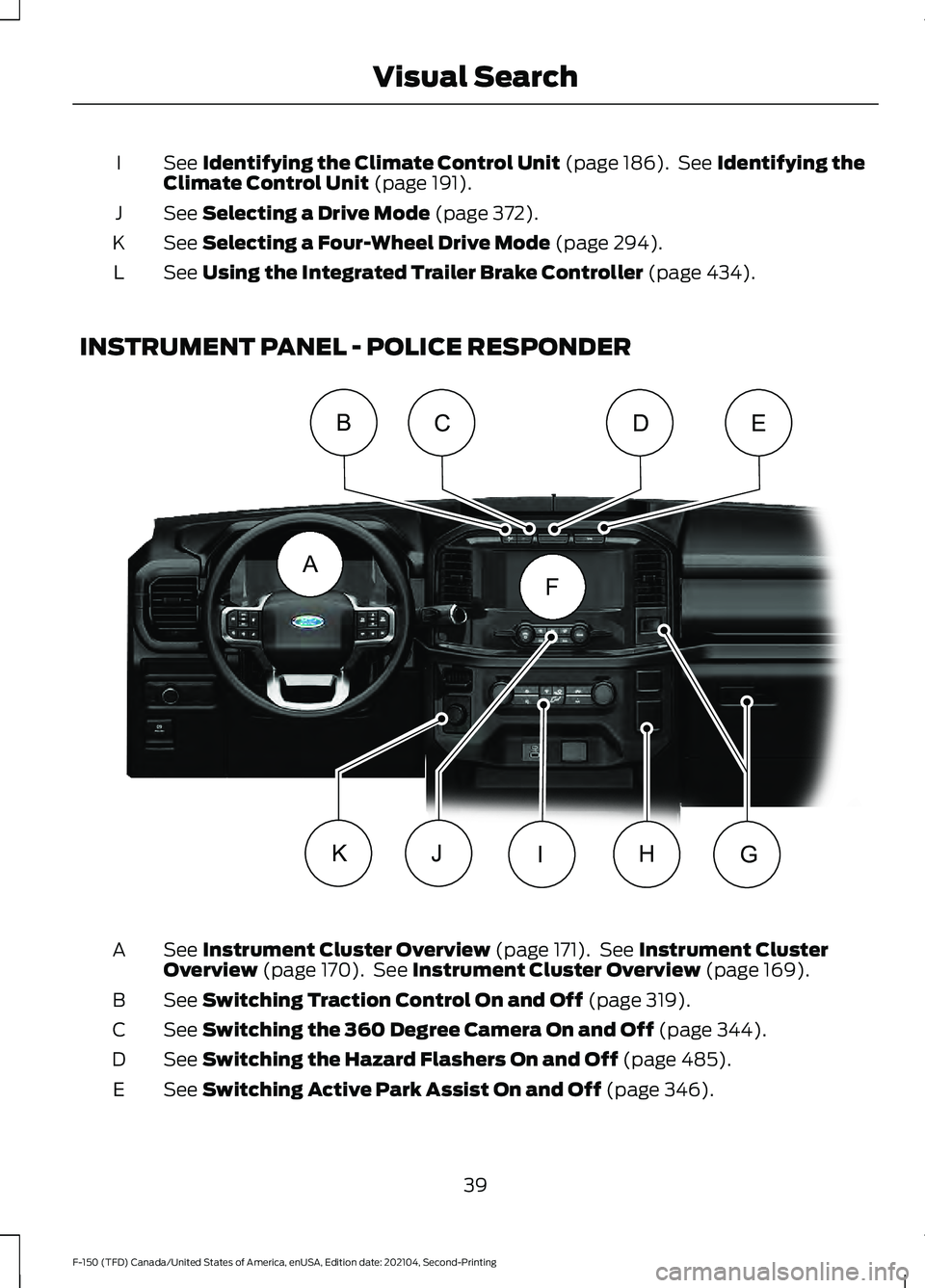
See Identifying the Climate Control Unit (page 186). See Identifying the
Climate Control Unit (page 191).
I
See
Selecting a Drive Mode (page 372).
J
See
Selecting a Four-Wheel Drive Mode (page 294).
K
See
Using the Integrated Trailer Brake Controller (page 434).
L
INSTRUMENT PANEL - POLICE RESPONDER See
Instrument Cluster Overview (page 171). See Instrument Cluster
Overview (page 170). See Instrument Cluster Overview (page 169).
A
See
Switching Traction Control On and Off (page 319).
B
See
Switching the 360 Degree Camera On and Off (page 344).
C
See
Switching the Hazard Flashers On and Off (page 485).
D
See
Switching Active Park Assist On and Off (page 346).
E
39
F-150 (TFD) Canada/United States of America, enUSA, Edition date: 202104, Second-Printing Visual SearchA
BCDE
F
HIJKGE343531
Page 103 of 796

Emergency Assistance
If you set emergency assistance to always
on, you cannot switch it off with a MyKey.
Do Not Disturb
If you set do not disturb to always on, you
cannot switch it off with a MyKey.
Note:
If a phone is connected using Apple
CarPlay or Android Auto while driving with
a MyKey, the driver can receive phone calls
and text messages even if the do not disturb
restriction is on, and if the vehicle comes
with satellite radio, there is no restriction on
the adult content.
Traction and Stability Control
If you set traction control or stability
control to always on, you cannot switch it
off with a MyKey.
CREATING A MYKEY -
VEHICLES WITH: PUSH
BUTTON START
Vehicles with a center console shifter: 1. Remove the mat from the center
console cup holder.
2. Remove the key blade from the transmitter. 3.
Place the remote control in the backup
slot with the buttons facing toward the
front of the vehicle.
4. Switch the ignition on using an admin key.
5. Press Settings on the touchscreen.
6. Press
Vehicle Settings.
7. Press
MyKey.
8. Press
Create MyKey.
9. Press
Yes.
Note: After you confirm the creation of a
MyKey, we recommend that you label this
key.
Vehicles with a column shifter. 1. Raise the front center seat storage lid.
2.
Place the remote control in the backup
slot with the buttons facing toward the
front of the vehicle.
3. Switch the ignition on using an admin key.
4. Press
Settings on the touchscreen.
5. Press
Vehicle Settings.
6. Press
MyKey.
7. Press
Create MyKey.
8. Press
Yes.
Note: After you confirm the creation of a
MyKey, we recommend that you label this
key.
99
F-150 (TFD) Canada/United States of America, enUSA, Edition date: 202104, Second-Printing MyKey
™
(If Equipped)E312216 E269950
Page 179 of 796
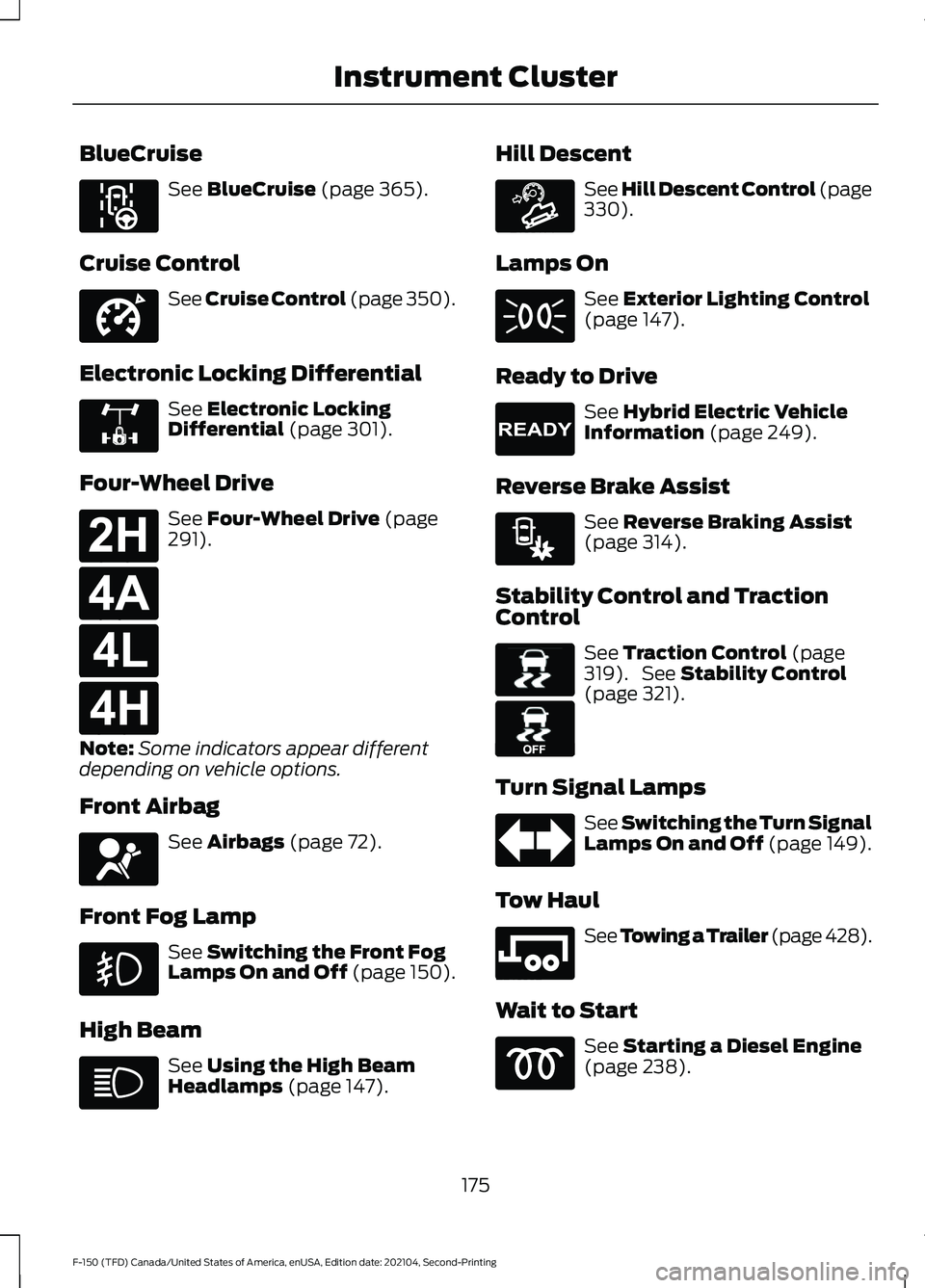
BlueCruise
See BlueCruise (page 365).
Cruise Control See Cruise Control (page 350).
Electronic Locking Differential See
Electronic Locking
Differential (page 301).
Four-Wheel Drive See
Four-Wheel Drive (page
291).
Note: Some indicators appear different
depending on vehicle options.
Front Airbag See
Airbags (page 72).
Front Fog Lamp See
Switching the Front Fog
Lamps On and Off (page 150).
High Beam See
Using the High Beam
Headlamps (page 147). Hill Descent See Hill Descent Control
(page
330).
Lamps On See
Exterior Lighting Control
(page 147).
Ready to Drive See
Hybrid Electric Vehicle
Information (page 249).
Reverse Brake Assist See
Reverse Braking Assist
(page 314).
Stability Control and Traction
Control See
Traction Control (page
319). See Stability Control
(page 321).
Turn Signal Lamps See Switching the Turn Signal
Lamps On and Off (page 149).
Tow Haul See
Towing a Trailer (page 428).
Wait to Start See
Starting a Diesel Engine
(page 238).
175
F-150 (TFD) Canada/United States of America, enUSA, Edition date: 202104, Second-Printing Instrument ClusterE297977 E332905 E325779 E181778 E181781 E181780 E181779 E67017 E163171 E224090 E293490 E138639 E130458 E246592
Page 181 of 796

Lamps On
See Exterior Lighting Control
(page 147).
Police Engine Idle See Police Engine Idle Feature.
Ready to Drive See
Hybrid Electric Vehicle
Information (page 249).
Reverse Brake Assist See
Reverse Braking Assist
(page 314).
Stability Control and Traction
Control See
Traction Control (page
319). See Stability Control
(page 321).
Turn Signal Lamps See Switching the Turn Signal
Lamps On and Off (page 149).
Tow Haul See
Towing a Trailer (page 428).
Wait to Start See
Starting a Diesel Engine
(page 238).
177
F-150 (TFD) Canada/United States of America, enUSA, Edition date: 202104, Second-Printing Instrument Cluster E224045 E224090 E293490 E138639 E130458 E246592
Page 296 of 796

sand, steep slopes, or pulling heavy
objects. Additionally, the system is capable
of recreational flat towing by putting the
transfer case into neutral (N). See
Recreationally Towing Your Vehicle
(page
490).
There is further information on driving in
unique driving conditions.
See Off-Road
Driving (page 470).
FOUR-WHEEL DRIVE
PRECAUTIONS WARNING:
Vehicles with a higher
center of gravity (utility and four-wheel
drive vehicles) handle differently than
vehicles with a lower center of gravity
(passenger cars). Avoid sharp turns,
excessive speed and abrupt steering in
these vehicles. Failure to drive cautiously
increases the risk of losing control of your
vehicle, vehicle rollover, personal injury
and death. WARNING:
Do not become
overconfident in the ability of four-wheel
drive vehicles. Although a four-wheel
drive vehicle may accelerate better than
a two-wheel drive vehicle in low traction
situations, it won't stop any faster than
two-wheel drive vehicles. Always drive
at a safe speed.
Truck and utility vehicles can differ from
some other vehicles. Your vehicle could be
higher to allow it to travel over rough
terrain without getting stuck or damaging
underbody components. The differences
that make your vehicle so versatile also
make it handle differently than an ordinary
passenger car. Always maintain steering
wheel control, especially in rough terrain.
Since sudden changes in terrain can result
in abrupt steering wheel motion, make sure
you grip the steering wheel from the outside. Do not grip the spokes. Drive
cautiously to avoid vehicle damage from
concealed objects such as rocks and
stumps. Drive slower in strong crosswinds
which can affect the normal steering
characteristics of your vehicle. Be
extremely careful when driving on
pavement made slippery by loose sand,
water, gravel, snow or ice.
Note:
Do not use four-wheel drive high or
four-wheel drive low mode on dry, hard
surfaced roads. Doing so can produce
excessive noise, increase tire wear and can
damage drive components.
FOUR-WHEEL DRIVE
LIMITATIONS
Operating Four-Wheel Drive with
a Spare or Mismatched Tires
(If
Equipped)
On four-wheel drive vehicles, the size of
the spare tire can affect the four-wheel
drive system. If there is a significant
difference between the size of the spare
tire and the remaining tires, you could have
limited four-wheel drive functionality.
When driving with the full-size dissimilar
spare wheel and tire assembly, we
recommend that you do not:
• Exceed
50 mph (80 km/h) with a
four-wheel drive mode turned on.
• Turn on a four-wheel drive mode
unless the vehicle is stationary.
• Use a four-wheel drive mode on dry
pavement.
Driving with the full-size dissimilar spare
wheel and tire assembly can limit
four-wheel drive functionality, especially
when driving in a mechanically locked
four-wheel drive mode. You can experience
the following:
292
F-150 (TFD) Canada/United States of America, enUSA, Edition date: 202104, Second-Printing Four-Wheel Drive
(If Equipped)
Page 299 of 796
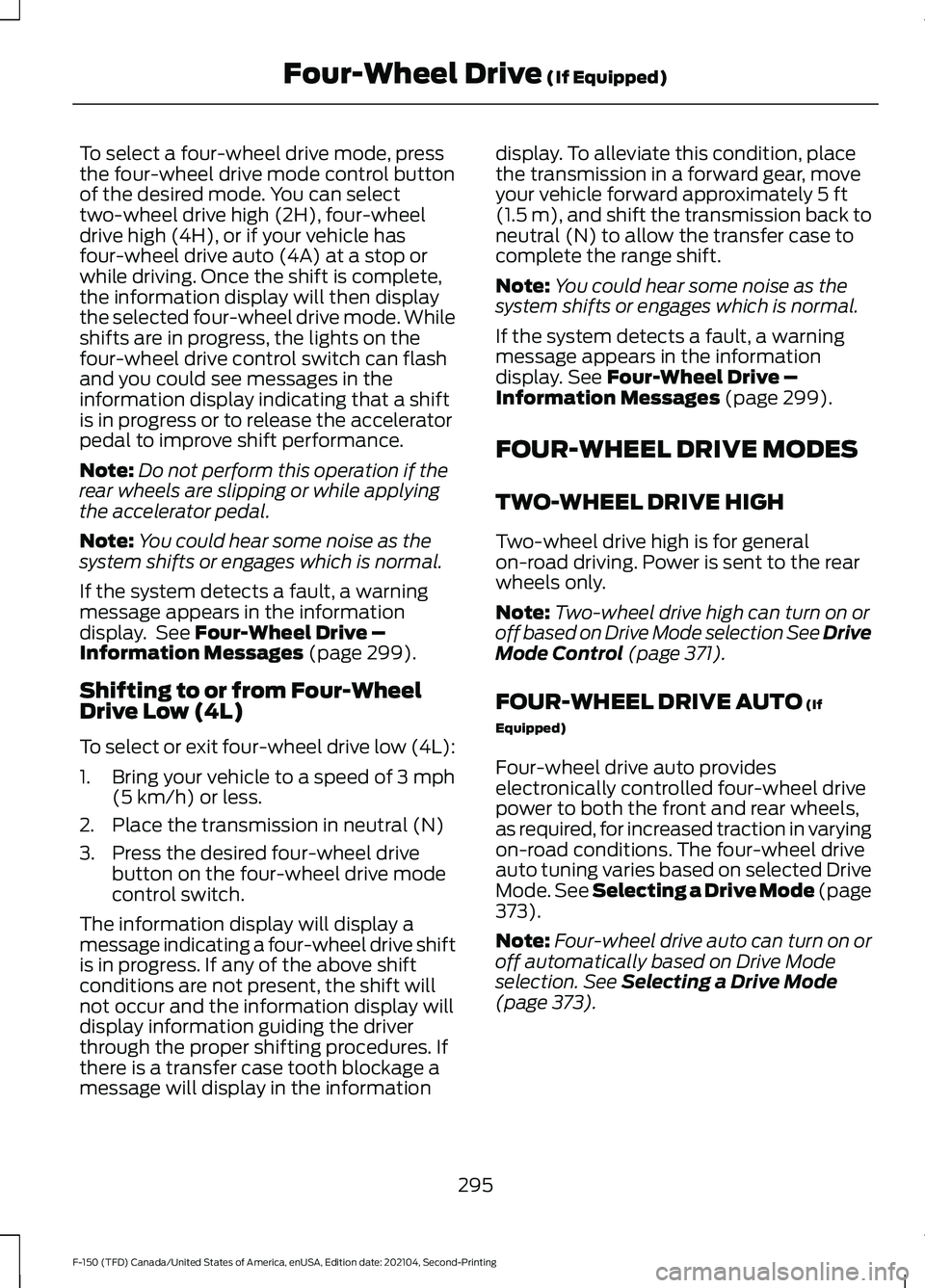
To select a four-wheel drive mode, press
the four-wheel drive mode control button
of the desired mode. You can select
two-wheel drive high (2H), four-wheel
drive high (4H), or if your vehicle has
four-wheel drive auto (4A) at a stop or
while driving. Once the shift is complete,
the information display will then display
the selected four-wheel drive mode. While
shifts are in progress, the lights on the
four-wheel drive control switch can flash
and you could see messages in the
information display indicating that a shift
is in progress or to release the accelerator
pedal to improve shift performance.
Note:
Do not perform this operation if the
rear wheels are slipping or while applying
the accelerator pedal.
Note: You could hear some noise as the
system shifts or engages which is normal.
If the system detects a fault, a warning
message appears in the information
display. See Four-Wheel Drive –
Information Messages (page 299).
Shifting to or from Four-Wheel
Drive Low (4L)
To select or exit four-wheel drive low (4L):
1. Bring your vehicle to a speed of
3 mph
(5 km/h) or less.
2. Place the transmission in neutral (N)
3. Press the desired four-wheel drive button on the four-wheel drive mode
control switch.
The information display will display a
message indicating a four-wheel drive shift
is in progress. If any of the above shift
conditions are not present, the shift will
not occur and the information display will
display information guiding the driver
through the proper shifting procedures. If
there is a transfer case tooth blockage a
message will display in the information display. To alleviate this condition, place
the transmission in a forward gear, move
your vehicle forward approximately
5 ft
(1.5 m), and shift the transmission back to
neutral (N) to allow the transfer case to
complete the range shift.
Note: You could hear some noise as the
system shifts or engages which is normal.
If the system detects a fault, a warning
message appears in the information
display.
See Four-Wheel Drive –
Information Messages (page 299).
FOUR-WHEEL DRIVE MODES
TWO-WHEEL DRIVE HIGH
Two-wheel drive high is for general
on-road driving. Power is sent to the rear
wheels only.
Note: Two-wheel drive high can turn on or
off based on Drive Mode selection See Drive
Mode Control
(page 371).
FOUR-WHEEL DRIVE AUTO
(If
Equipped)
Four-wheel drive auto provides
electronically controlled four-wheel drive
power to both the front and rear wheels,
as required, for increased traction in varying
on-road conditions. The four-wheel drive
auto tuning varies based on selected Drive
Mode.
See Selecting a Drive Mode (page
373).
Note: Four-wheel drive auto can turn on or
off automatically based on Drive Mode
selection.
See Selecting a Drive Mode
(page 373).
295
F-150 (TFD) Canada/United States of America, enUSA, Edition date: 202104, Second-Printing Four-Wheel Drive
(If Equipped)